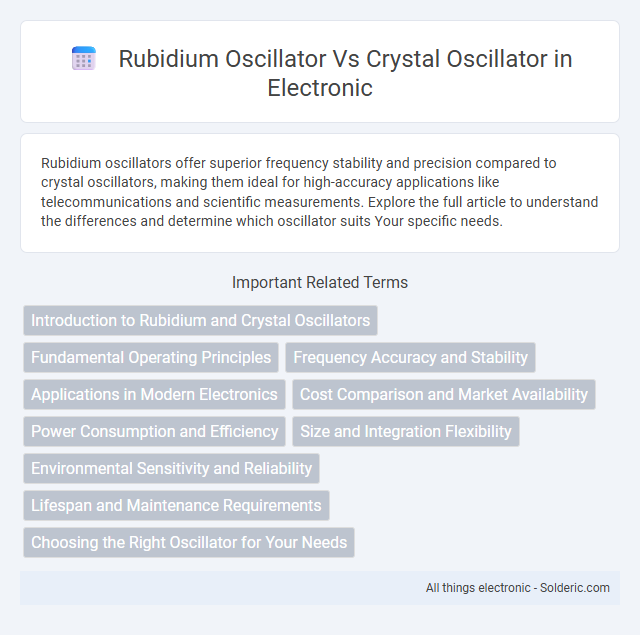Rubidium oscillators offer superior frequency stability and precision compared to crystal oscillators, making them ideal for high-accuracy applications like telecommunications and scientific measurements. Explore the full article to understand the differences and determine which oscillator suits Your specific needs.
Comparison Table
| Feature | Rubidium Oscillator | Crystal Oscillator |
|---|---|---|
| Frequency Stability | +-5x10-11 over 1 day | +-10-6 to +-10-9 over 1 day |
| Accuracy | Better than +-5x10-11 | Typically +-10-6 |
| Temperature Sensitivity | Minimal, with internal compensation | High, requires temperature control |
| Size & Weight | Larger and heavier (approximately several kg) | Compact and lightweight (few grams) |
| Power Consumption | High (several watts) | Low (milliwatts) |
| Cost | High (thousands of USD) | Low (few USD) |
| Typical Use Cases | Precision timing, GPS, telecommunications | Consumer electronics, watches, microcontrollers |
| Warm-up Time | Several minutes | Instant or milliseconds |
Introduction to Rubidium and Crystal Oscillators
Rubidium oscillators use the hyperfine transition frequency of rubidium atoms to provide highly stable and accurate frequency references, ideal for precision timing applications. Crystal oscillators rely on the piezoelectric properties of quartz crystals to generate consistent frequencies but generally offer less long-term stability than rubidium oscillators. Your choice between rubidium and crystal oscillators depends on the required stability, accuracy, and budget constraints of your timing system.
Fundamental Operating Principles
Rubidium oscillators use the hyperfine transition frequency of rubidium atoms as a reference, providing exceptional frequency stability through atomic resonance. Crystal oscillators rely on the piezoelectric effect in quartz crystals to generate oscillations at a consistent frequency, but their stability can be affected by temperature and aging. Your choice depends on whether ultra-high precision or cost-effectiveness is the priority.
Frequency Accuracy and Stability
Rubidium oscillators offer superior frequency accuracy and stability compared to crystal oscillators, with frequency stability typically reaching parts per 10^11 over extended periods. Crystal oscillators, while more affordable, often exhibit frequency variations on the order of parts per 10^7 to 10^9, influenced by temperature changes and aging. For applications demanding precise timing, such as telecommunications or GPS systems, using a rubidium oscillator ensures your system maintains exceptional long-term frequency stability.
Applications in Modern Electronics
Rubidium oscillators provide ultra-stable frequency references essential for precision applications such as GPS satellite systems, telecommunications networks, and deep-space communication, where long-term frequency stability and low phase noise are paramount. Crystal oscillators, commonly found in consumer electronics, embedded systems, and industrial equipment, offer cost-effective and reliable timing solutions ideal for moderate frequency stability requirements in clocks, microprocessors, and wireless devices. The choice between rubidium and crystal oscillators depends on application demands, with rubidium excelling in high-precision environments and crystal oscillators serving widespread timing needs in everyday electronic devices.
Cost Comparison and Market Availability
Rubidium oscillators typically cost significantly more than crystal oscillators due to their advanced atomic timekeeping technology, with prices often reaching thousands of dollars compared to the few dollars for standard crystal units. Crystal oscillators enjoy widespread market availability, being extensively used in consumer electronics, telecommunications, and computing industries, whereas rubidium oscillators are primarily found in specialized applications like GPS, telecommunications infrastructure, and scientific research. The limited production volume and specialized components of rubidium oscillators contribute to their higher cost and lower market availability compared to mass-produced crystal oscillators.
Power Consumption and Efficiency
Rubidium oscillators consume more power than crystal oscillators due to their atomic reference systems requiring continuous heating and stabilization, which impacts overall efficiency. Crystal oscillators operate with significantly lower power consumption, making them ideal for battery-powered and energy-sensitive applications. Your choice depends on whether high frequency stability or power efficiency is the priority in your specific use case.
Size and Integration Flexibility
Rubidium oscillators are generally larger and heavier than crystal oscillators due to their atomic frequency reference components, limiting their integration into compact devices. Crystal oscillators offer superior size reduction and flexible integration options, making them ideal for miniaturized circuits and portable applications. Your choice depends on whether size constraints or frequency stability requirements take precedence.
Environmental Sensitivity and Reliability
Rubidium oscillators exhibit superior environmental stability compared to crystal oscillators, maintaining precise frequency under temperature fluctuations, humidity, and vibration due to their atomic resonance-based design. Your applications demanding high reliability benefit from rubidium oscillators' long-term stability and minimal drift, outperforming crystal oscillators that are more susceptible to aging and environmental factors. These characteristics make rubidium oscillators ideal for mission-critical systems requiring consistent timing accuracy in harsh conditions.
Lifespan and Maintenance Requirements
Rubidium oscillators boast a lifespan of over 10 years with minimal maintenance, providing highly stable frequency references ideal for critical applications. Crystal oscillators typically have shorter lifespans, often around 5 to 10 years, and may require periodic calibration to maintain accuracy. Your choice between these oscillators should consider rubidium's superior longevity and lower maintenance against the cost-effectiveness and simplicity of crystal oscillators.
Choosing the Right Oscillator for Your Needs
Rubidium oscillators provide superior frequency stability and long-term accuracy compared to crystal oscillators, making them ideal for high-precision applications such as telecommunications, GPS, and scientific research. Crystal oscillators are more cost-effective, compact, and power-efficient, suitable for consumer electronics and everyday devices where moderate frequency stability suffices. Evaluate your specific requirements for accuracy, stability, size, and budget to choose the right oscillator for your needs.
rubidium oscillator vs crystal oscillator Infographic

 solderic.com
solderic.com